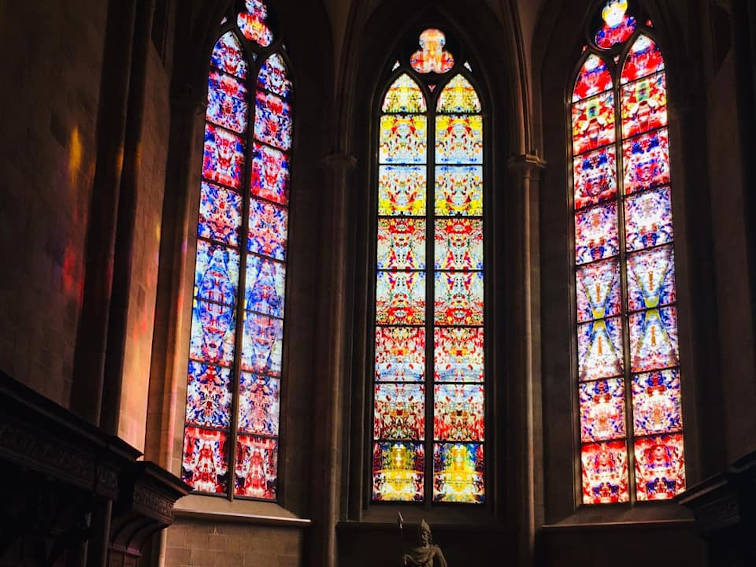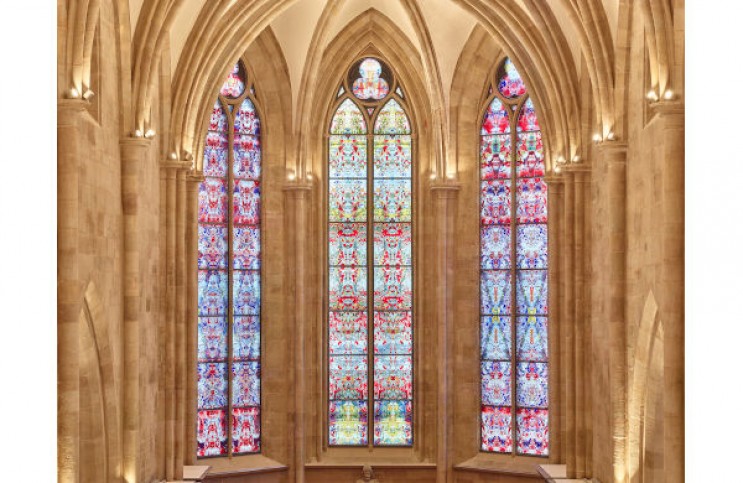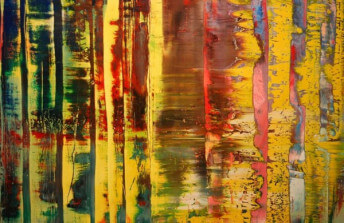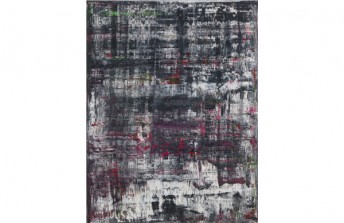Gerhard Richter's Last Major Work? Stained Glass at a Monastery
Sep 23, 2020
Gerhard Richter has amassed a catalogue raisonné that now approaches 1000 major works, many of which are considered masterpieces. Yet, it is his most recent, and some say final, major work—a set of monumental stained glass windows installed recently in the oldest monastery in Germany—that may ultimately be remembered as his most successful. The 30-foot tall windows tower over the altar of Tholey Abbey, a Benedictine monastery located in the southern German district of Sankt Wendel in Saarland. The Abbey dates back at least to 634 AD, and currently houses 12 monks. Richter designed the windows based on a project begun decades ago, in which he sub-divides an earlier abstract painting into vertical strips, then mirrors the strips, repeating the mirrored images to create a pattern. He published a book based on his Pattern project in 2011, titled Gerhard Richter: Patterns: Divided - Mirrored - Repeated. The book shows how each subsequent division (starting with 2, then 4, then 8, and so on, up to 4096) results in smaller and smaller strips. As the strips shrink, the pattern their repetition creates becomes more simplified until finally it simply becomes stripes. For the stained glass windows, Richter started with the same painting that he used for the book—an oil on canvas work from 1990 titled “Abstract Painting” (number 724-4 in his catalogue raisonné). He divided it into a series of vertically mirrored patters, then mirrored each of those patterns horizontally. The three sets of windows contain five mirrored sections each. The finished work is completely abstract, and Richter is a self-described agnostic, yet the architectural surroundings nonetheless lend the windows an unmistakably religious character. This combination of references, from the symbolic to the mystical to the abstract, lays the groundwork for viewers to interpret the windows in infinitely subjective ways.
A Collaborative Experience
While credit for the design of the windows at Tholey Monastery belongs to Richter, the project could never have been realized without assistance from multiple other parties. According to a report by Catherine Hickley for the New York Times News Service, it was a local organist who took the leap of faith of reaching out to Richter in the first place to ask him to do the windows. Even in the unlikely event Richter agreed, everyone involved in the project figured that the Abbey could never afford the fee they were sure Richter would charge (since his paintings routinely sell for millions of dollars). Yet, to their shock, Richter not only agreed to do the project, but he offered his services free of charge. Other locals, meanwhile, had already been busy for nearly a decade generously paying for the renovation of the dilapidated, Gothic Abbey, in order to get it to the point where it could even sustain the installation of new windows.

Gerhard Richter’s new stained glass windows in Tholey Abbey. Courtesy Tholey Abbey
And the collaboration did not end there. Only the finest craftspeople could have tackled the complicated window design Richter had in mind. The team at The Gustav van Treeck glass studios in Munich deployed a range of complicated and delicate techniques, from the ancient to the contemporary, to being the windows to life. Everything from traditional sketches and models to digital imaging technology was used to guide them in their work. In order to simulate the same painterly effects that Richter achieved in his original painting, the glass workers had to use a combination of painting and layering the panes of glass. The result of this team effort is a work of art that itself collaborates with the forces of architecture and nature to create its effects. Sunlight and space respond to the windows in unpredictable and dramatic ways, instigating an evolving aesthetic experience that is open to anyone, regardless of religious affiliations or spiritual beliefs.
The Patterns of History
Many writers have been quick to point out that this is not the first stained glass window Richter has created. In 2007, he designed a massive, abstract window for Cologne Cathedral made up of 11,263 colored squares, which was simultaneously derided by some and applauded by others when it debuted. However, I feel that this latest stained glass window project has less in common with Cologne Cathedral, and more in common with a different Richter project—the two monumental works he painted for the Reichstag. “Schwarz, Rot, Gold (Black, Red, Gold)” (1999), is a 204-meter tall ode to the German flag. Facing it from across the lobby of the building, “Birkenau” (2014) is an equally massive, abstracted remembrance of a series of photographs taken by members of the Sonderkommando, Jewish prisoners tasked with burning the bodies of victims of the Nazi gas chambers at Auschwitz-Birkenau concentration camp.

Gerhard Richter’s new stained glass windows in Tholey Abbey. Courtesy Tholey Abbey
There are obvious differences between the Reichstag paintings and the Tholey Monastery windows. First and foremost, the Reichstag paintings are rooted in figuration and symbolism, while the Tholey Monastery windows are completely abstract. What makes them similar anyway in my opinion has to do with their potential to spark memories and emotions in the minds of viewers. With his Reichstag works, Richter suggests the best and worst aspects of German history, while leaving ample room for contemporary Germans to decide what it means. The more you study the works, the more layers of potential meaning are revealed. Similarly, his Tholey Monastery windows suggest both the most regimented aspects of the human search for transcendence—represented by the church—and the most open aspects of this quest—represented by abstract art. Just as with the Reichstag works, the Tholey Abbey windows can be experienced in a purely visual way, or perhaps more careful viewers might be rewarded with a glimpse of greater mysteries. Both of these installations succeed, in my opinion, because they live up to the lofty goal Richter once gave himself, “to bring together in a living and viable way the most different and the most contradictory elements in the greatest possible freedom.”
Featured image: Gerhard Richter’s new stained glass windows in Tholey Abbey. Courtesy Tholey Abbey
All images used for illustrative purposes only
By Phillip Barcio



